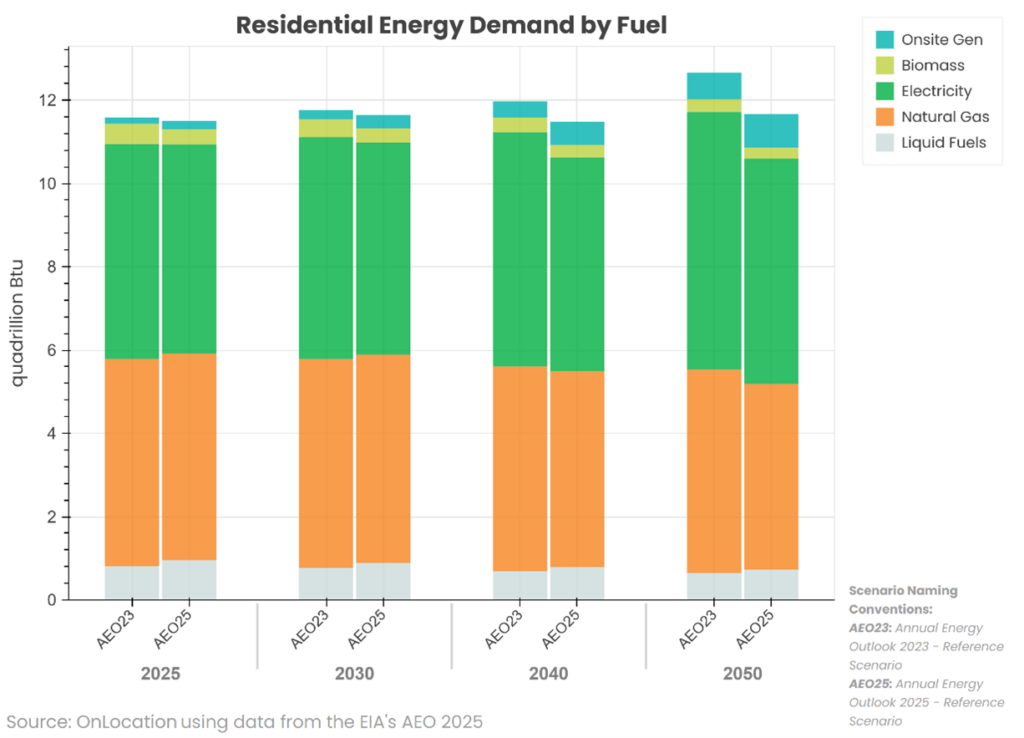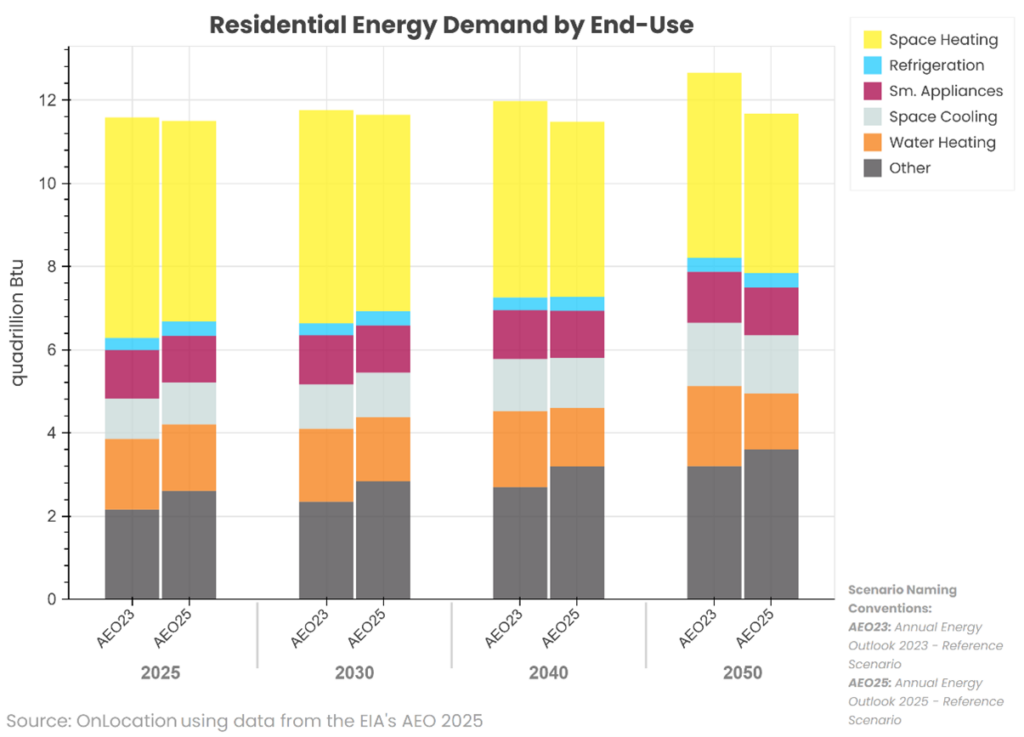AEO 2025 Trends: Residential Sector in Focus
The U.S. Energy Information Administration’s (EIA) Annual Energy Outlook (AEO) 2025 introduces significant changes in how the residential sector is modeled. As part of OnLocation’s weekly “AEO 2025 Trends” series, this blog examines the AEO 2025 projections with a focus on this sector. The AEO provides an important benchmark of U.S. energy system projections to various government agencies, research institutions, and industry leaders. These projections rely on the National Energy Modeling System (NEMS), a U.S. energy-economic model that is an industry standard with detailed data and representation of energy markets, policies, and technologies in all energy supply and demand sectors.
EIA updated the underlying data of the residential sector using the 2020 Residential Energy Consumption Survey (RECS), recalibrated key parameters based on more recent market behavior, and expanded the representation of federal and regional policies to reflect those in place as of December 2024. Together, these changes result in projections that better reflect current housing characteristics, equipment trends, and consumer decision-making across U.S. households.
This post highlights what those updates mean for residential energy demand. We begin by examining how total consumption and fuel use evolve over time and how AEO 2025 differs from AEO 2023. We then turn to end-use consumption trends and conclude with a discussion of recent federal policy changes and how they may affect the sector going forward.
A New Picture of Residential Energy Demand
Figure 1 shows projected residential energy demand by fuel through 2050. In the AEO 2025 Reference case, total energy consumption in the residential sector remains relatively flat, increasing just five percent from 2025 to 2050.

Figure 1. Residential Energy Demand by Fuel – AEO 2023 and AEO 2025 Reference Scenarios
Compared to AEO 2023, the level of residential energy demand in AEO 2025 is noticeably lower. That difference reflects a series of updates in AEO 2025. First, the projection for the number of housing units is slightly higher, by about one to two percent, but that growth is offset by a downward revision in average floor space per home, which drops by roughly eight percent. Smaller homes, all else equal, tend to use less energy. In addition, there are greater improvements in energy efficiency due to updated equipment cost and performance specifications, updated consumer behavior, extended tax credits, and new appliance standards.
The fuel mix also shifts over time. Electricity becomes increasingly dominant, rising from 47% of residential delivered energy use in 2025 to 53% in 2050 in the AEO 2025. At the same time, natural gas falls from 41% to 38%, and total fossil fuel use, including natural gas, fuel oil, and biomass, declines from 53% to 47%. These trends highlight the continuing electrification of residential end uses, as older fossil fuel appliances are replaced with electric alternatives in both new and existing homes.
Shifting Uses: How Energy Is Used in the Home
Figure 2 shows residential energy demand by end use. These include familiar categories such as space heating, space cooling, water heating, and refrigeration.

Figure 2. Residential Energy Demand by End-Use – AEO 2023 and AEO 2025 Reference Scenarios
The AEO 2025 updates lead to notable shifts in the end-use breakdown. One of the most significant changes appears in water heating. In AEO 2025, energy consumption for water heating declines steadily over time. As a share of total residential energy use, it falls by 16% between 2025 and 2050. That contrasts with the AEO 2023 trajectory, which showed a 14% increase over the same period. The downward revision reflects the finalized water heater efficiency standards that will be in effect in 2029, updated assumptions about equipment efficiency and revised consumer behavior parameters that better align with historical purchase patterns.
Looking more broadly at end-use patterns, space heating and water heating together account for about half of all residential energy use. In AEO 2025, their combined consumption falls by 13% from 2025 to 2050. Meanwhile, space cooling grows 32% over the same period. That is lower than the 60% increase projected in AEO 2023. The fastest growing end use in both Outlooks is the other category which is made up of smaller appliances and miscellaneous uses. Those uses are also estimated to be higher in 2025 based on the latest RECS survey.
The Policy Backdrop: From IRA to OBBBA
The Inflation Reduction Act (IRA) of 2022 created and expanded several tax credits to encourage energy efficiency and electrification in buildings. The recently enacted One Big Beautiful Bill Act (OBBBA) shifted policy priorities and phased out many of these incentives.
Starting after 2025, OBBBA removes several residential tax credits:
- Section 25C, the Energy Efficient Home Improvement Credit that provides credits for high efficiency home appliance replacements
- Section 25D, the Residential Clean Energy Credit for PV systems, geothermal heat pumps, batteries and the like
- Section 45L, the New Energy Efficient Home Credit (after mid-2026)
These changes reflect a broader revision of fiscal priorities and a shift away from climate mitigation goals. AEO 2025 does not yet reflect these changes, as the modeling assumptions were finalized before OBBBA’s enactment. Our consultants are uniquely qualified to provide our clients with customized scenarios, including the representation of OBBBA, using the NEMS model.
For more insights into the AEO 2025 scenario results, see the recent blogs in our AEO 2025 Trends series including Powering Future Demand, Grid Reliability and Critical Materials, Driving Policy Change, Oil and Gas Supply, Growing Electricity Demand for Data Centers, The Outlook for Coal, Implications for Carbon Dioxide Emissions, and Enhanced Decarbonization Opportunities as well as our initial AEO 2025 overview blog posted soon after the AEO release in April.

